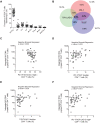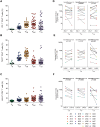CD4+ T Cells Expressing PD-1, TIGIT and LAG-3 Contribute to HIV Persistence during ART
- PMID: 27415008
- PMCID: PMC4944956
- DOI: 10.1371/journal.ppat.1005761
CD4+ T Cells Expressing PD-1, TIGIT and LAG-3 Contribute to HIV Persistence during ART
Abstract
HIV persists in a small pool of latently infected cells despite antiretroviral therapy (ART). Identifying cellular markers expressed at the surface of these cells may lead to novel therapeutic strategies to reduce the size of the HIV reservoir. We hypothesized that CD4+ T cells expressing immune checkpoint molecules would be enriched in HIV-infected cells in individuals receiving suppressive ART. Expression levels of 7 immune checkpoint molecules (PD-1, CTLA-4, LAG-3, TIGIT, TIM-3, CD160 and 2B4) as well as 4 markers of HIV persistence (integrated and total HIV DNA, 2-LTR circles and cell-associated unspliced HIV RNA) were measured in PBMCs from 48 virally suppressed individuals. Using negative binomial regression models, we identified PD-1, TIGIT and LAG-3 as immune checkpoint molecules positively associated with the frequency of CD4+ T cells harboring integrated HIV DNA. The frequency of CD4+ T cells co-expressing PD-1, TIGIT and LAG-3 independently predicted the frequency of cells harboring integrated HIV DNA. Quantification of HIV genomes in highly purified cell subsets from blood further revealed that expressions of PD-1, TIGIT and LAG-3 were associated with HIV-infected cells in distinct memory CD4+ T cell subsets. CD4+ T cells co-expressing the three markers were highly enriched for integrated viral genomes (median of 8.2 fold compared to total CD4+ T cells). Importantly, most cells carrying inducible HIV genomes expressed at least one of these markers (median contribution of cells expressing LAG-3, PD-1 or TIGIT to the inducible reservoir = 76%). Our data provide evidence that CD4+ T cells expressing PD-1, TIGIT and LAG-3 alone or in combination are enriched for persistent HIV during ART and suggest that immune checkpoint blockers directed against these receptors may represent valuable tools to target latently infected cells in virally suppressed individuals.
Conflict of interest statement
The authors have declared that no competing interests exist.
Figures




References
-
- Perelson AS, Essunger P, Cao Y, Vesanen M, Hurley A, Saksela K, et al. Decay characteristics of HIV-1-infected compartments during combination therapy. Nature. 1997;387: 188–191. - PubMed
-
- Palella FJ, Delaney KM, Moorman AC, Loveless MO, Fuhrer J, Satten GA, et al. Declining morbidity and mortality among patients with advanced human immunodeficiency virus infection. HIV Outpatient Study Investigators. N Engl J Med. 1998;338: 853–860. - PubMed
-
- Chun T-W, Justement JS, Murray D, Hallahan CW, Maenza J, Collier AC, et al. Rebound of plasma viremia following cessation of antiretroviral therapy despite profoundly low levels of HIV reservoir: implications for eradication. AIDS. 2010;24: 2803–2808. 10.1097/QAD.0b013e328340a239 - DOI - PMC - PubMed
Publication types
MeSH terms
Substances
Grants and funding
LinkOut - more resources
Full Text Sources
Other Literature Sources
Medical
Research Materials

